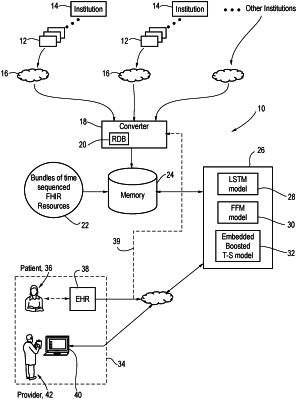| CPC G16H 10/60 (2018.01) [G06N 3/044 (2023.01); G06N 3/045 (2023.01); G06N 3/08 (2013.01); G16H 15/00 (2018.01); G16H 50/30 (2018.01); G16H 50/20 (2018.01)] | 16 Claims |

|
1. A system comprising, in combination,
a) a computer executing one or more deep learning models trained on aggregated health records converted into a single standardized data structure format and presented to the one or more deep learning models in a time sequence ordered arrangement per patient, the aggregated health records including a combination of at least free text medical notes, laboratory values, and medications; the one or more deep learning models predicting one or more future clinical events and identifying one or more pertinent past medical events related to the predicted one or more future clinical events for a patient based on an input electronic health record of the patient having the standardized data structure format, wherein the electronic health record of the patient comprises a plurality of individual health record elements, wherein the computer executing a particular model of the one or more deep learning models based on the input electronic health record comprises (i) determining an embedding vector for each bag of a plurality of bags of the individual elements of the input electronic health record, wherein determining an embedding vector for a particular bag of the plurality of bags comprises determining a first average embedding vector that averages embedding vectors representing free text medical notes of individual elements of the input electronic health record that are in the particular bag, determining a second average embedding vector that averages embedding vectors representing laboratory values of individual elements of the input electronic health record that are in the particular bag, determining a third average embedding vector that averages embedding vectors representing medications of individual elements of the input electronic health record that are in the particular bag, and concatenating the first, second, and third average vectors to generate the embedding vector for the particular bag, and (ii) applying each of the embedding vectors individually and sequentially to the particular model in chronological order ; wherein at least one of the one or more deep learning models includes an attention mechanism indicating how much attention the at least one of the one or more models gave to the individual elements in the electronic health record to predict the one or more future clinical events; and
b) a healthcare provider-facing interface of an electronic device for use by a healthcare provider treating the patient configured to display both (1) the predicted one or more future clinical events and (2) the identified one or more pertinent past medical events of the patient in the input electronic health record, including at least a free text medical note or excerpt thereof, whereby the display of the identified one or more pertinent past medical events of the patient in the input electronic health record together with the predicted one or more future clinical events facilitates the provider focusing on elements in the electronic health record which are relevant to the predicted one or more future clinical events.
|